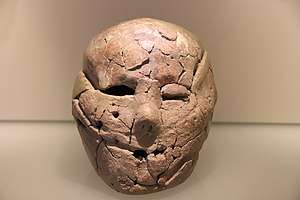Teraphim
Teraphim (Hebrew: תרף teraph; plural: Hebrew: תרפים teraphim) is a Hebrew word from the Bible, found only in the plural, of uncertain etymology.[1] Despite being plural, Teraphim may refer to singular objects, using the Hebrew plural of excellence.[2] The word Teraphim is explained in classical rabbinical literature as meaning disgraceful things[3] (dismissed by modern etymologists), and in many English translations of the Bible it is translated as idols, or household god(s), though its exact meaning is more specific than this, but unknown precisely.
Teraphim in the Hebrew Bible

Rachel
According to Genesis 31, Rachel takes the teraphim belonging to her father Laban when her husband Jacob escapes. She hides them in a saddle bag and sits on them when Laban comes looking for them, and claims that she cannot get up because she is menstruating. From this it can be deduced that they were small, perhaps 30–35 cm.[4] Her exact motive in doing so is subject to controversy amongst the commentators: Some argue she took the teraphim in order that her father not have idolatrous paraphernalia, while others explain that she wanted to use them herself.[5]
Michal
In 1 Samuel 19, Michal helps her husband David to escape from her father Saul. She lets him out through a window, and then tricks Saul's men into thinking that a teraphim in her bed is actually David. This suggests the size and shape is that of a man.[6] It also refers to "the" teraphim, which implies that there was a place for teraphim in every household. Van der Toorn claims that "there is no hint of indignation at the presence of teraphim in David's house."[7] However, the same word is used in 1 Samuel 15:23 where Samuel rebukes Saul and tells him that "presumption is as iniquity and teraphim". Here the idea is that rebellion is just as bad as teraphim, the use of which is thus denounced as idolatry. Others explain that the teraphim in this context refer to decorative statues, not to idolatrous ritual items.[8]
Other passages
The teraphim were outlawed in Josiah's reform (2 Kings 23:24), but are mentioned again in Hosea 3:4, where it says that "the Israelites will live many days without king or prince, without sacrifice or sacred stones, without ephod or teraphim." As in the narrative of Micah's Idol the teraphim is closely associated with the ephod, and both are mentioned elsewhere in connection with divination;[1] it is thus a possibility that the Teraphim were involved with the process of cleromancy.
In Zechariah 10:2 it states: "For the teraphim utter nonsense, and the diviners see lies; the dreamers tell false dreams, and give empty consolation. Therefore the people wander like sheep; they are afflicted for want of a shepherd."
In post-biblical writing
Josephus mentions that there was a custom of carrying housegods on journeys to foreign lands,[9] and it is thus possible that the use of teraphim continued in popular culture well into the Hellenic era and possibly beyond.[3]

According to Targum Pseudo-Jonathan, Teraphim were made from the heads of slaughtered first born male adult humans, shaved, salted, spiced, with a golden plate placed under the tongue, and magic words engraved upon the plate; it was believed that the Teraphim, mounted on the wall, would talk to people.[3] Similar explanations are cited in the writings of Eleazar of Worms and Tobiah ben Eliezer.[10]
During the excavation of Jericho by Kathleen Kenyon, evidence of the use of human skulls as cult objects was uncovered, lending credence to the rabbinical conjecture.[11] The implied size and the fact that Michal could pretend that one was David, has led to the rabbinical conjecture that they were heads, possibly mummified human heads.[1]
Suggested meaning and use
Casper Labuschagne claims that it comes via metathesis from the root פתר, "to interpret".[12] Karel Van der Toorn argues that they were ancestor figurines rather than household deities, and that the "current interpretation of the teraphim as household deities suffers from a onesided use of Mesopotamian material."[13]
That Micah, who worshipped Yahweh, used the Teraphim as an idol, and that Laban regarded the Teraphim as representing his gods, is thought to indicate that they were evidently images of Yahweh.[3] It is considered possible that they originated as a fetish, possibly initially representative of ancestors, but gradually becoming oracular.[3]
Benno Landsberger and later Harry Hoffner derive the word from Hittite tarpiš, "the evil daemon".[14]
Notes
- Smith, William Robertson; Box, George Herbert (1911). . In Chisholm, Hugh (ed.). Encyclopædia Britannica. 26 (11th ed.). Cambridge University Press. p. 637.
- Van Der Toorn, 206.
- Jewish Encyclopedia
- Van Der Toorn, 205.
- Reuven Chaim Klein (2018). God versus Gods: Judaism in the Age of Idolatry. Mosaica Press. pp. 65–66. ISBN 978-1946351463.
- BDB, p. 1076.
- Van Der Toorn, 216.
- Reuven Chaim Klein (2018). God versus Gods: Judaism in the Age of Idolatry. Mosaica Press. pp. 139–141. ISBN 978-1946351463.
- Josephus, Antiquities of the Jews, volume 18, 9:5
- Reuven Chaim Klein (2018). God versus Gods: Judaism in the Age of Idolatry. Mosaica Press. p. 361. ISBN 978-1946351463.
- Peake's commentary on the Bible
- Casper Labuschagne, "Teraphim : a new proposal for its etymology," Vetus Testamentum 16 [1966] 116.
- Van Der Toorn, 222.
- https://www.academia.edu/3620016/Hittite_tarpis_and_Hebrew_teraphim
References
- Karel Van Der Toorn, "The Nature of the Biblical Teraphim in the Light of Cuneiform Evidence," CBQ 52 (1990), 203-222.